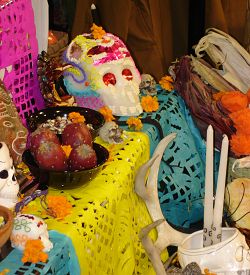The Day of the Dead: A celebration full of life

WEST VALLEY CITY — "Nothing is certain in this life, except death," says an old saying. No matter how inevitable death is, very few want to encounter it. However, something very peculiar occurs in Mexico: death causes fear and respect at the same time it provokes veneration and mockery. This ambivalence of the Mexican people with the "bony one" translates into the Day of the Dead. "This is an occasion to remember and honor those who have died," said Yolanda Espinoza, a volunteer for the celebration that took place at the Utah Cultural Celebration Center (UCCC). This is the fifth year Una Mano Amiga, a non-profit organization, and UCCC have joined forces to preserve the Day of the Dead tradition among Hispanics, and promote education and respect for this celebration among other cultures. "Community participation has increased year after year," said Rocio Mejia, director of Una Mano Amiga. Mejia added that she is happy to notice the participation of Hispanics has also risen. This means, "They believe in our culture and they want to recover it," she said surrounded by a musical environment that evoked the bittersweet taste of death. The Day of the Dead is the product of a fusion of the Aztec culture and Christian traditions. The Aztecs celebrated the end of the maze harvest during the first full moon of November. They believed that on this day, their fallen could come back to Earth and be part of the festivity. To persuade them to come back, the Aztecs would make the favorite dishes of their departed and would take them to the urns that contained their ashes, a prevalent tradition that was part of the altar in the UCCC exhibit. A typical altar has three levels that, according to some, represent the present, the past, and the future. Others consider that the levels portray the three phases of the Church: Church Militant, Church Suffering, and Church Triumphant. Besides their favorite food and drinks, the altar includes pictures of the dead as well as flowers, sugar skulls, and marigold petals , among other things. Before the colonization, the marigold petals were used to point the way to Mictlan, or "residence of the dead." Nowadays, the petals are directed toward an image of Christ or the Virgin. Like the Aztec tradition, the Catholic doctrine says death is not the end of life. In his second letter to the Corinthians, Saint Paul said "We are confident, I say, and willing rather to be absent from this body, and to be present with the Lord." (2 Co 5: 8). On November 2, the Church celebrates the Feast of All Souls. Pope Benedict XVI said in a letter that on this day "The Church invites everyone to pray for the dead" with the hope "that their memory will have us meditate on eternity, guiding our lives toward values that will never perish." John Paul II highlighted the need to pray for the departed in a letter sent in 2002 to the Minim Sisters of Our Lady of Suffrage saying that "Christian love knows no boundaries and goes beyond the limits of space and time, enabling us to love those who have already left this earth." Therefore, the Church recommends praying, giving alms, and doing indulgences and works of penance in favor of the dead, especially during the day that was established for this purpose.
© Copyright 2024 The Diocese of Salt Lake City. All rights reserved.

Stay Connected With Us